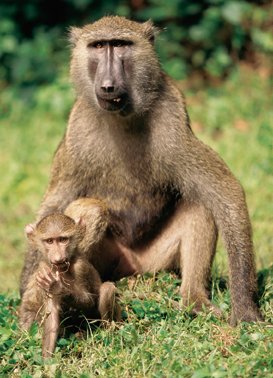Get Mellow, Fellow: Male baboons cooperate after cultural prodding
Adult male baboons are bad dudes. They regularly square off in bloody fights over access to food and females, whom they will also attack. In this vicious pecking order, males at the top bully bottom dwellers into a demoralized state of submission.

So, it startled Stanford University biologists Robert M. Sapolsky and Lisa J. Share to find a baboon troop in which even top-rung males exhibited remarkably peaceful behaviors. The big honchos often left weak males alone and refrained from attacking females, focusing instead on fighting each other.
It’s a uniquely “pacific culture” among wild baboons, Sapolsky and Share conclude.
A decade earlier, the most aggressive males in this troop had died. The current top males arrived later and have no close genetic ties to the other members, past or present. Male baboons typically migrate into a troop as adolescents.
To achieve the big chill-out in male behavior, the researchers theorize, resident females must behave in ways that induce males to be tolerant and cooperative.
The findings provide the first known example of the cultural transmission of social attitudes by primates other than people, the researchers report in the April Public Library of Science Biology.
“Social behavior observed in nature may be a product of culture, and even the fiercest primates do not forever need to stay this way,” remarks chimp researcher Frans B.M. de Waal of Emory University in Atlanta in an editorial published with the new report.
Possible cultural traditions of tool use and social communication in various animals now attract considerable scientific interest (SN: 4/3/04, p. 218: Monkey Business).
Sapolsky and Share began studying Forest Troop, a group of olive baboons living in an animal reserve in Kenya, in 1978. The size of such troops varies from about 30 to 150 animals.
In 1982, the most aggressive Forest Troop males began foraging in a garbage pit at a tourist lodge in the reserve. The next year, infected meat in the dump killed all these dominant males, so only the troop’s relatively easygoing males survived. By 1986, aggressive behavior in the troop had declined markedly.
The most interesting observations began in 1993. By that time, the troop contained high-ranking immigrant males. From 1993 to 1996, these males behaved as cooperatively as the original set of lower-ranking male survivors had, the scientists say. Compared with males in another troop in the same area, Forest
Troop males were friendlier with each other and spent less time jockeying for power.
Moreover, low-ranking Forest Troop males didn’t display high stress-hormone concentrations that have been observed among their counterparts in other troops.
Forest Troop females somehow steer male newcomers into adopting cooperative outlooks, the investigators propose. Intriguingly, Sapolsky and Share have observed that these females approach new male arrivals and begin to groom them after waiting about 3 weeks, one-quarter the time required by females in the nearby group. Forest Troop females then continue to spend much time in mutual grooming with these males.
Sapolsky and Share make “a strong case” that norms of peaceful behavior were transmitted to new Forest Troop members, comments baboon researcher Joan B. Silk of the University of California, Los Angeles. Only more-intensive study can establish how this process occurs and whether the troop attracts males of all temperaments or only those already inclined to a placid lifestyle, Silk says.